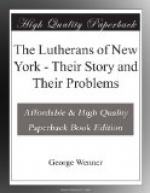Julius Ehrhardt was an unassuming, lovable and scholarly Suabian. He laid the foundations of St. Paul’s in Harlem, when the little wooden church stood among the truck gardens. He died in 1899.
Moldenke was a descendant of Salzburg exiles who settled in East Prussia in 1731. He came to us from Wisconsin, organized Zion Church which was subsequently merged with St. Peter’s after he had accepted a call to succeed Hennicke in that church. He was an able preacher and a scholarly writer. Under his leadership St. Peter’s became a strong congregation. In 1872 he contributed a series of articles on Die Lutheraner des Ostens to Der Pilger of Reading. A reprint of these articles in book form would be a valuable contribution to the story of the Lutherans of New York and a fitting memorial of a minister of mark and influence.
Johann Heinrich Sieker was born in Schweinfurth, Bavaria, October 23d, 1839. He received his theological education at Gettysburg. His early ministry was in connection with the Wisconsin Synod. In 1876, when Ruperti resigned at St. Matthew’s, Sieker was called from St. Paul, Minnesota, to become his successor. For 28 years he was the pastor of St. Matthew’s and a leading minister of the Missouri Synod. In synodical matters he was an uncompromising defender of the faith as he understood it. He left the record of a singularly devoted and successful ministry. At least thirty young men were led into the ministry under his influence. Roesner’s “Ehrendenkmal,” a sketch of his life and character, ought to be read by every Lutheran minister in this city. He died in 1904.
John Jacob Young was a native of the Rhenish Palatinate, born at Langenkandel, September 13th, 1846. He came to America in his boyhood. He served in the Union army during the Civil War. When the war was over he studied for the ministry at Gettysburg. He served a number of congregations in Maryland and Indiana till 1893, when he was called to the pastorate of St. John’s in Christopher Street. Here for 21 years he faithfully followed his calling as a shepherd of souls.
Charles Armand Miller came to us from the South. He was born in Sheperdstown, West Virginia, March 7, 1864. He was educated at Roanoke College and after his ordination he was for a time pastor of the College Church. He succeeded Dr. Krotel in Holy Trinity Church in 1896 and gave twelve years of devoted and successful service to this congregation. His subsequent fields of labor were in Charleston, South Carolina, and in Philadelphia. He was a scholarly writer, an able preacher, a sympathetic pastor and a loyal friend. Among his published writings were The Perfect Prayer, The Sacramental Feast, The Way to the Cross and a volume of poems entitled Ad Astra.
[illustration: “Pastor J. H. Sieker”]
He died in the prime of his life, September 9th, 1917. Who that knew him will ever forget the genial spirit of Charles Armand Miller?




